Seasonal and Diurnal Variations of Indoor PM2.5 in Six Households in Akure, Nigeria
Abstract
1. Introduction
2. Materials and Methods
2.1. Observation Sites
2.2. Characteristics of the Households
2.3. PM2.5 Measurements
2.4. Exposure Risk Estimation
3. Results and Discussion
3.1. Seasonal Variation in PM2.5 in the Kitchen and Living Room
3.2. Site-to-Site and Diurnal Variations in PM2.5 in the Kitchen
3.3. Site-to-Site and Diurnal Variations in PM2.5 in the Living Room
3.4. Comparison with Literature Studies on Indoor PM2.5
3.5. Exposure Risk Estimate
4. Conclusions
Supplementary Materials
Author Contributions
Funding
Institutional Review Board Statement
Informed Consent Statement
Data Availability Statement
Acknowledgments
Conflicts of Interest
References
- World Health Organization. WHO, Household Air Pollution. 2024. Available online: https://www.who.int/news-room/fact-sheets/detail/household-air-pollution-and-health (accessed on 1 December 2024).
- Pai, S.J.; Carter, T.S.; Heald, C.L.; Kroll, J.H. Updated world health organization air quality guidelines highlight the importance of non-anthropogenic PM2.5. Environ. Sci. Technol. Lett. 2022, 9, 501–506. [Google Scholar] [CrossRef] [PubMed]
- Yu, W.; Xu, R.; Ye, T.; Abramson, M.J.; Morawska, L.; Jalaludin, B.; Johnston, F.H.; Henderson, S.B.; Knibbs, L.D.; Morgan, G.G.; et al. Estimates of global mortality burden associated with short-term exposure to fine particulate matter (PM2.5). Lancet Planet. Health 2024, 8, e146–e155. [Google Scholar] [CrossRef] [PubMed]
- Chen, J.; Hoek, G.; de Hoogh, K.; Rodopoulou, S.; Andersen, Z.J.; Bellander, T.; Brandt, J.; Fecht, D.; Forastiere, F.; Gulliver, J.; et al. Long-term exposure to source-specific fine particles and mortality─A pooled analysis of 14 European cohorts within the ELAPSE project. Environ. Sci. Technol. 2022, 56, 9277–9290. [Google Scholar] [CrossRef] [PubMed]
- McDuffie, E.E.; Martin, R.V.; Spadaro, J.V.; Burnett, R.; Smith, S.J.; O’Rourke, P.; Hammer, M.S.; van Donkelaar, A.; Bindle, L.; Shah, V.; et al. Source sector and fuel contributions to ambient PM2.5 and attributable mortality across multiple spatial scales. Nat. Commun. 2021, 12, 3594. [Google Scholar] [CrossRef]
- Aboubacar, B.; Deyi, X.; Razak, M.Y.A.; Leyla, B.H. The effect of PM2.5 from household combustion on life expectancy in Sub-Saharan Africa. Int. J. Environ. Res. Public Health 2018, 15, 748. [Google Scholar] [CrossRef]
- National Population Commission (NPC) [Nigeria]; ICF. Nigeria Demographic and Health Survey 2018; NPC: Abuja, Nigeria; ICF: Rockville, ML, USA, 2019. [Google Scholar]
- National Bureau of Statistics (NBS) [Nigeria]. Nigeria Living Standard Survey 2018/2019; National Bureau of Statistics: Abuja, Nigeria, 2020. [Google Scholar]
- National Population Commission (NPC) [Nigeria]; ICF Macro. Nigeria Demographic and Health Survey 2008; NPC: Abuja, Nigeria; ICF Macro: Rockville, ML, USA, 2009. [Google Scholar]
- Fawehinmi, A.S.; Oyerinde, O.V. Household energy in Nigeria: The Challenge of pricing and poverty in fuel switching. J. Energy Dev. 2002, 27, 277–284. Available online: https://www.jstor.org/stable/24808712 (accessed on 1 September 2024).
- Kumar, P.; Hama, S.; Abbass, R.A.; Nogueira, T.; Brand, V.S.; Wu, H.W.; Abulude, F.O.; Adelodun, A.A.; Anand, P.; Andrade, M.F.; et al. In-kitchen aerosol exposure in twelve cities across the globe. Environ. Int. 2022, 162, 107155. [Google Scholar] [CrossRef]
- Aigbokhaode, A.Q.; Isara, A.R. Household air pollution and respiratory symptoms of women and children in a suburban community in Nigeria. Turk. Thorac. J. 2021, 22, 466–472. [Google Scholar] [CrossRef]
- Giwa, S.O.; Nwaokocha, C.N.; Sharifpur, M. An appraisal of air quality, thermal comfort, acoustic, and health risk of household kitchens in a developing country. Environ. Sci. Pollut. Res. 2022, 29, 26202–26213. [Google Scholar] [CrossRef]
- Adianimovie, S.; Ebinimi, G. Investigation of particulate matter (PM10 & PM2.5) and gaseous pollutants (CO2 & CO) in houses using kerosene cooking stoves & wood fire in Attisa 3, Bayelsa State, Nigeria. NIPES J. Sci. Technol. Res. 2023, 5, 206–219. [Google Scholar] [CrossRef]
- Oluwole, O.; Ana, G.R.; Arinola, G.O.; Wiskel, T.; Falusi, A.G.; Huo, D.; Olopade, O.I.; Olopade, C.O. Effect of stove intervention on household air pollution and the respiratory health of women and children in rural Nigeria. Air Qual. Atmos. Health 2013, 6, 553–561. [Google Scholar] [CrossRef]
- Giwa, S.O.; Oladosu, J.O.; Sulaiman, M.A.; Taziwa, R.T.; Sharifpur, M. Influence of stove locations and ventilation conditions on kitchen air quality and thermal comfort during oil-cooking activities. Atmos. Pollut. Res. 2023, 14, 101882. [Google Scholar] [CrossRef]
- Abulude, F.O.; Feyisetan, A.O.; Arifalo, K.M.; Akinnusotu, A.; Bello, L.J. Indoor particulate matter assessment in a Northern Nigerian abattoir and a residential building. J. Atmos. Sci. Res. 2022, 5, 20–28. [Google Scholar] [CrossRef]
- Abulude, F.O.; Ratford, V.; Ratford, J.; Seelam, R.; Akinnusotu, A.; Olayinka, Y.V.; Arifalo, K.M.; Adamu, A.; Bello, L.J. Indoor air quality monitoring in Akure, Ondo State, Nigeria. Qual. Life 2024, 15, 13–28. [Google Scholar] [CrossRef]
- Abulude, F.O.; Suriano, D.; Oluwagbayide, S.D.; Akinnusotu, A.; Abulude, I.A.; Awogbindin, E. Study on indoor pollutants emission in Akure, Ondo State, Nigeria. Arab. Gulf J. Sci. Res. 2024, 42, 1643–1663. [Google Scholar] [CrossRef]
- Eghomwanre, A.F.; Oguntoke, O.; Taiwo, A.M. Levels of indoor particulate matter and association with asthma in children in Benin City, Nigeria. Environ. Monit. Assess. 2022, 194, 467. [Google Scholar] [CrossRef]
- Bachwenkizi, J.; Liu, C.; Meng, X.; Zhang, L.; Wang, W.; Donkelaar, A.V.; Martin, R.V.; Hammer, M.S.; Chen, R.; Kan, H. Maternal exposure to fine particulate matter and preterm birth and low birth weight in Africa. Environ. Int. 2022, 160, 107053. [Google Scholar] [CrossRef]
- Tajudeen, Y.; Mohammed, U.F.; Mohammed, Z.A.; Abdulazeez, A.; Abdulgafar, I.B.; Musa, B.; Adedayo, J. Concentrations and health risks of particulate matter (PM2.5) and associated elements in the ambient air of Lagos, Southwestern Nigeria. J. Biol. Res. Biotechnol. 2023, 21, 2141–2149. [Google Scholar] [CrossRef]
- Xu, H.; Léon, J.-F.; Liousse, C.; Guinot, B.; Yoboué, V.; Akpo, A.B.; Adon, J.; Ho, K.F.; Ho, S.S.H.; Li, L.; et al. Personal exposure to PM2.5 emitted from typical anthropogenic sources in southern West Africa: Chemical characteristics and associated health risks. Atmos. Chem. Phys. 2019, 19, 6637–6657. [Google Scholar] [CrossRef]
- Arku, R.E.; Dionisio, K.L.; Hughes, A.F.; Vallarino, J.; Spengler, J.D.; Castro, M.C.; Agyei-Mensah, S.; Ezzati, M. Personal particulate matter exposures and locations of students in four neighborhoods in Accra, Ghana. J. Expo. Sci. Environ. Epidemiol. 2015, 25, 557–566. [Google Scholar] [CrossRef]
- Piedrahita, R.; Kanyomse, E.; Coffey, E.; Xie, M.; Hagar, Y.; Alirigia, R.; Agyei, F.; Wiedinmyer, C.; Dickinson, K.L.; Oduro, A.; et al. Exposures to and origins of carbonaceous PM2.5 in a cookstove intervention in Northern Ghana. Sci. Total Environ. 2017, 576, 178–192. [Google Scholar] [CrossRef] [PubMed]
- Abulude, F.O.; Oluwagbayide, S.D.; Akinnusotu, A.; Elemide, O.A.; Gbotoso, A.O.; Ademilua, S.O.; Abulude, I.A. Indoor air quality in a tertiary institution: The case of Federal College of Agriculture, Akure, Nigeria. Aerosol Sci. Eng. 2024, 8, 1–12. [Google Scholar] [CrossRef]
- Ite, A.E.; Harry, T.A.; Obadimu, C.O.; Ekwere, I.O. Comparison of indoor air quality in schools: Urban vs. industrial ‘oil & gas’ zones in Akwa Ibom State—Nigeria. JEPHH. 2019, 7, 15–26. [Google Scholar] [CrossRef]
- Saetae, S.; Abulude, F.O.; Ndamitso, M.M.; Akinnusotu, A.; Oluwagbayide, S.D.; Matsumi, Y.; Kanegae, K.; Kawamoto, K.; Nakayama, T. Multi-year continuous observations of ambient PM2.5 at six sites in Akure, Southwestern Nigeria. Atmosphere. 2024, 15, 867. [Google Scholar] [CrossRef]
- UN. World Population Prospects 2024. United Nations. 2024. Available online: https://population.un.org/wpp/ (accessed on 1 December 2024).
- Dimari, G.A.; Hati, S.S.; Waziri, M.; Maitera, O.N. Pollution synergy from particulate matter sources: The Harmattan fugitive dust and combustion emission in Maiduguri Metropolis Nigeria. Eur. J. Sci. Res. 2008, 23, 465–471. [Google Scholar]
- Orogade, S.A.; Kayode, O.O.; Philip, K.H.; Donatus, B.A.; Abubakar, U.I.; Charles, A.O. Source apportionment of fine and coarse particulate matter in industrial areas of Kaduna, Northern Nigeria. Aerosol Air Qual. Res. 2016, 16, 1179–1190. [Google Scholar] [CrossRef]
- World Bank. Climate Change Knowledge Portal for Development Practitioners and Policy Makers, Climate Change Knowledge Portal. 2024. Available online: https://climateknowledgeportal.worldbank.org/country/nigeria (accessed on 1 December 2024).
- Nakayama, T.; Matsumi, Y.; Kawahito, K.; Watabe, Y. Development and evaluation of a palm-sized optical PM2.5 sensor. Aerosol Sci. Technol. 2018, 52, 2–12. [Google Scholar] [CrossRef]
- Ly, B.T.; Matsumi, Y.; Nakayama, T.; Sakamoto, Y.; Kajii, Y.; Nghiem, T.D. Characterizing PM2.5 in Hanoi with new high temporal resolution sensor. Aerosol Air Qual. Res. 2018, 18, 2487–2497. [Google Scholar] [CrossRef]
- Singh, T.; Matsumi, Y.; Nakayama, T.; Hayashida, S.; Patra, P.K.; Yasutomi, N.; Kajino, M.; Yamaji, K.; Khatri, P.; Takigawa, M.; et al. Very high particulate pollution over northwest India captured by a high-density in situ sensor network. Sci. Rep. 2023, 13, 13201. [Google Scholar] [CrossRef]
- USEPA. Conducting a Human Health Risk Assessment. The United States Environmental Protection Agency. 2024. Available online: https://www.epa.gov/risk/conducting-human-health-risk-assessment (accessed on 30 December 2024).
- WHO. WHO Global Air Quality Guidelines: Particulate Matter (PM2.5 and PM10), Ozone, Nitrogen Dioxide, Sulfur Dioxide and Carbon Monoxide. World Health Organization. 2021. Available online: https://apps.who.int/iris/handle/10665/345329 (accessed on 30 August 2024).
- National Environmental Standards and Regulations Enforcement Agency (NESREA). Ambient Air Quality Standards for Criteria Pollutants and Air Toxic. Schedule XIII. Regulation 29. 30 and 33. Fed. Repub. Niger. Off. Gaz. 2021, 108, 3373. [Google Scholar]

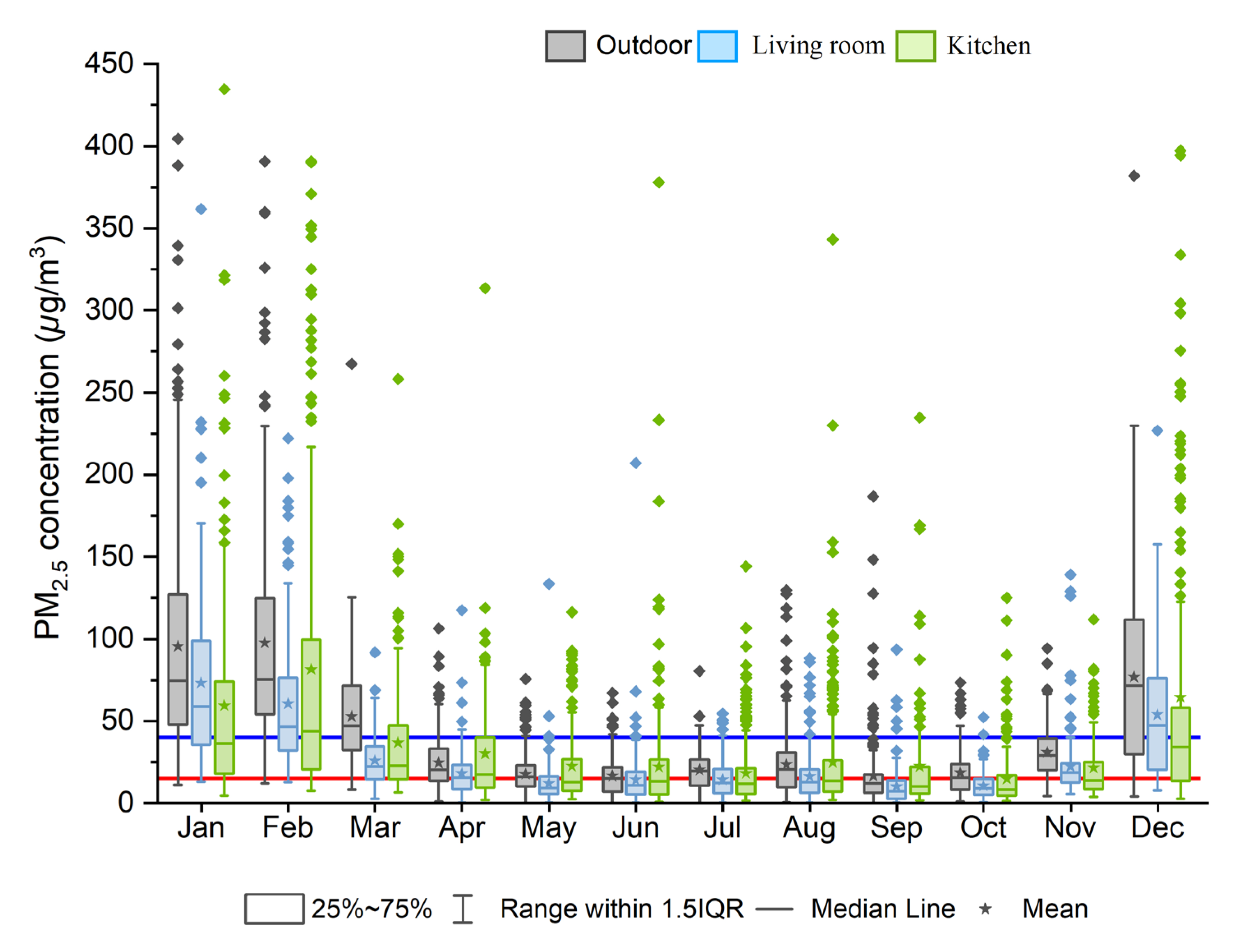
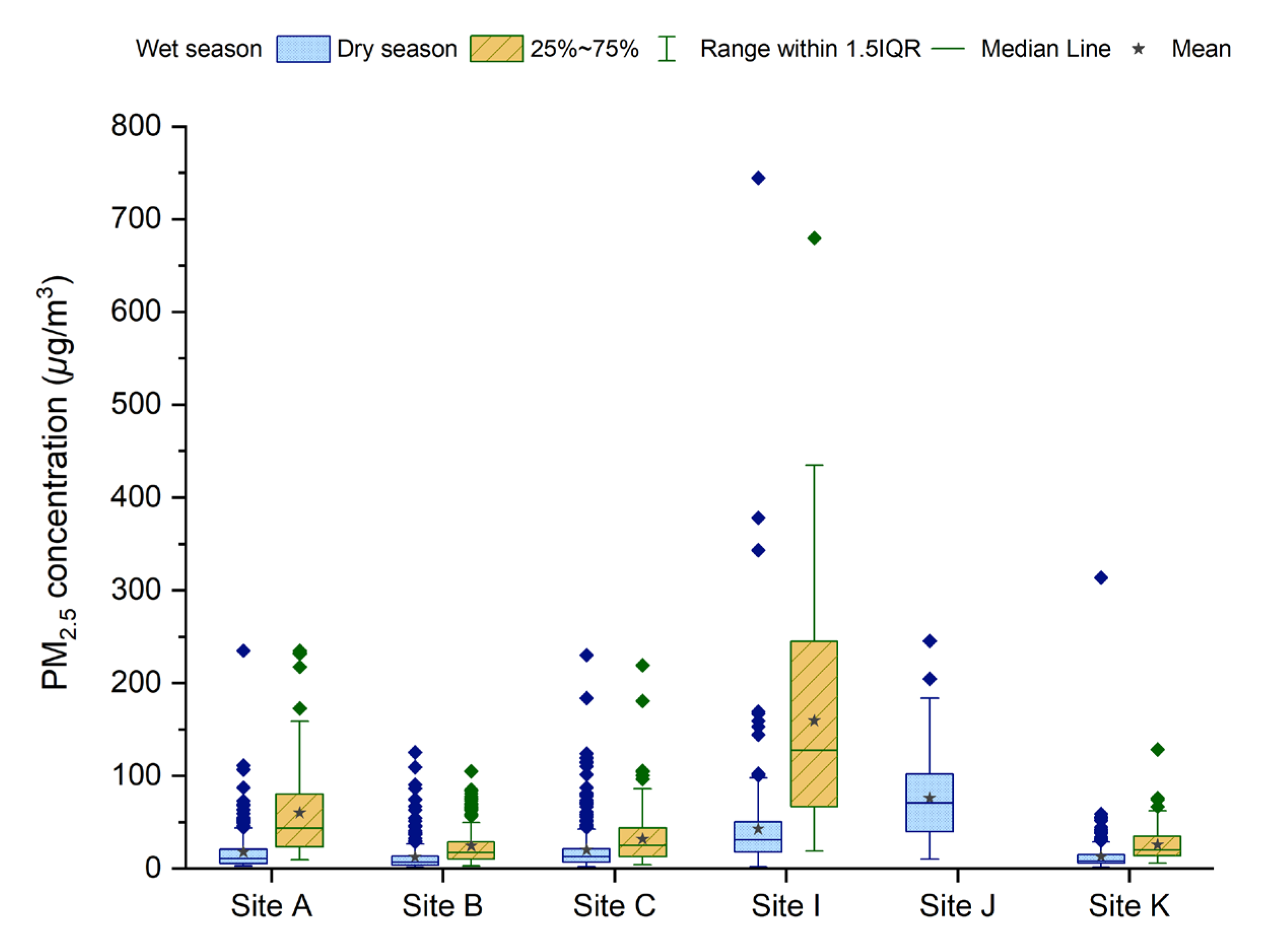

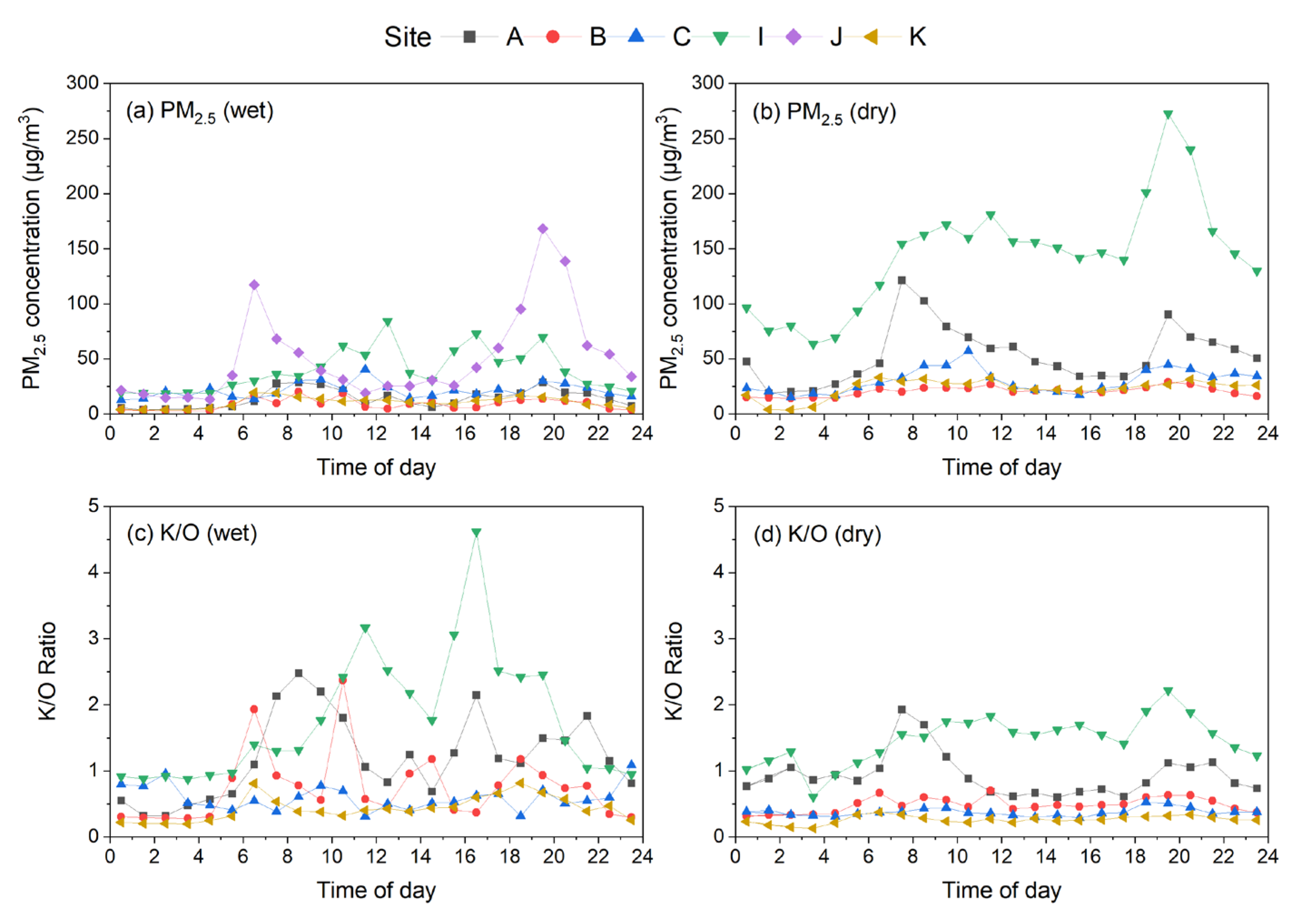
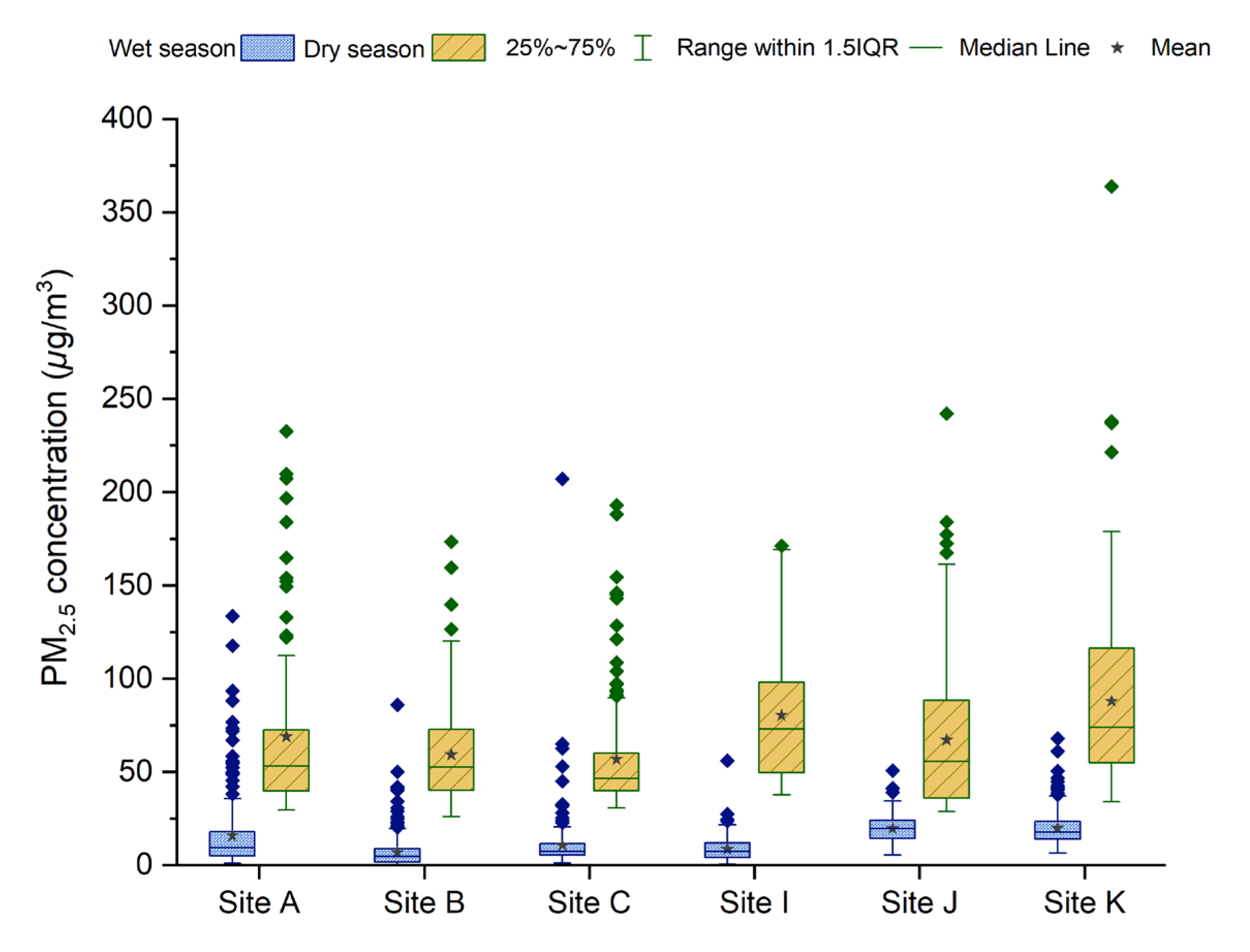
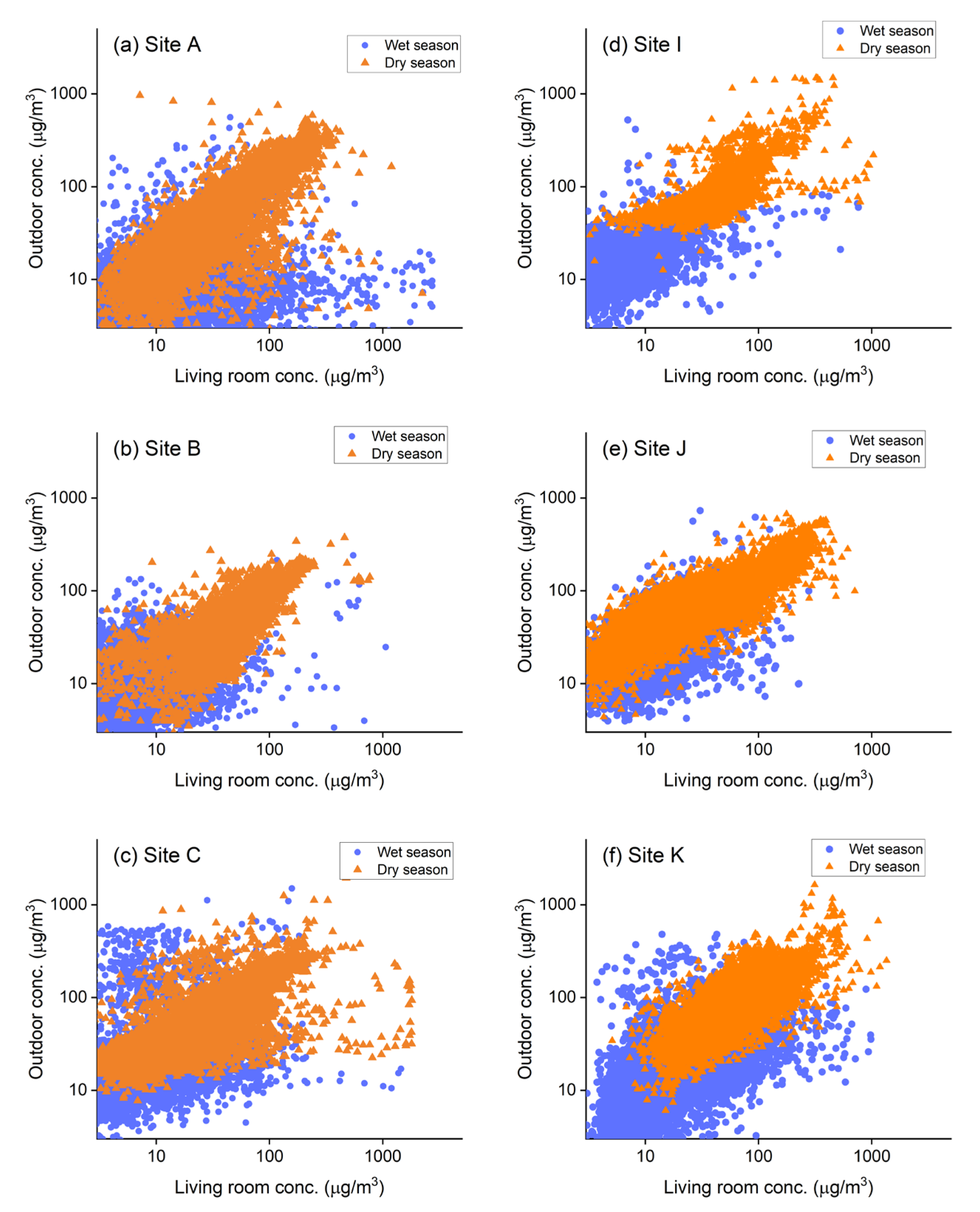

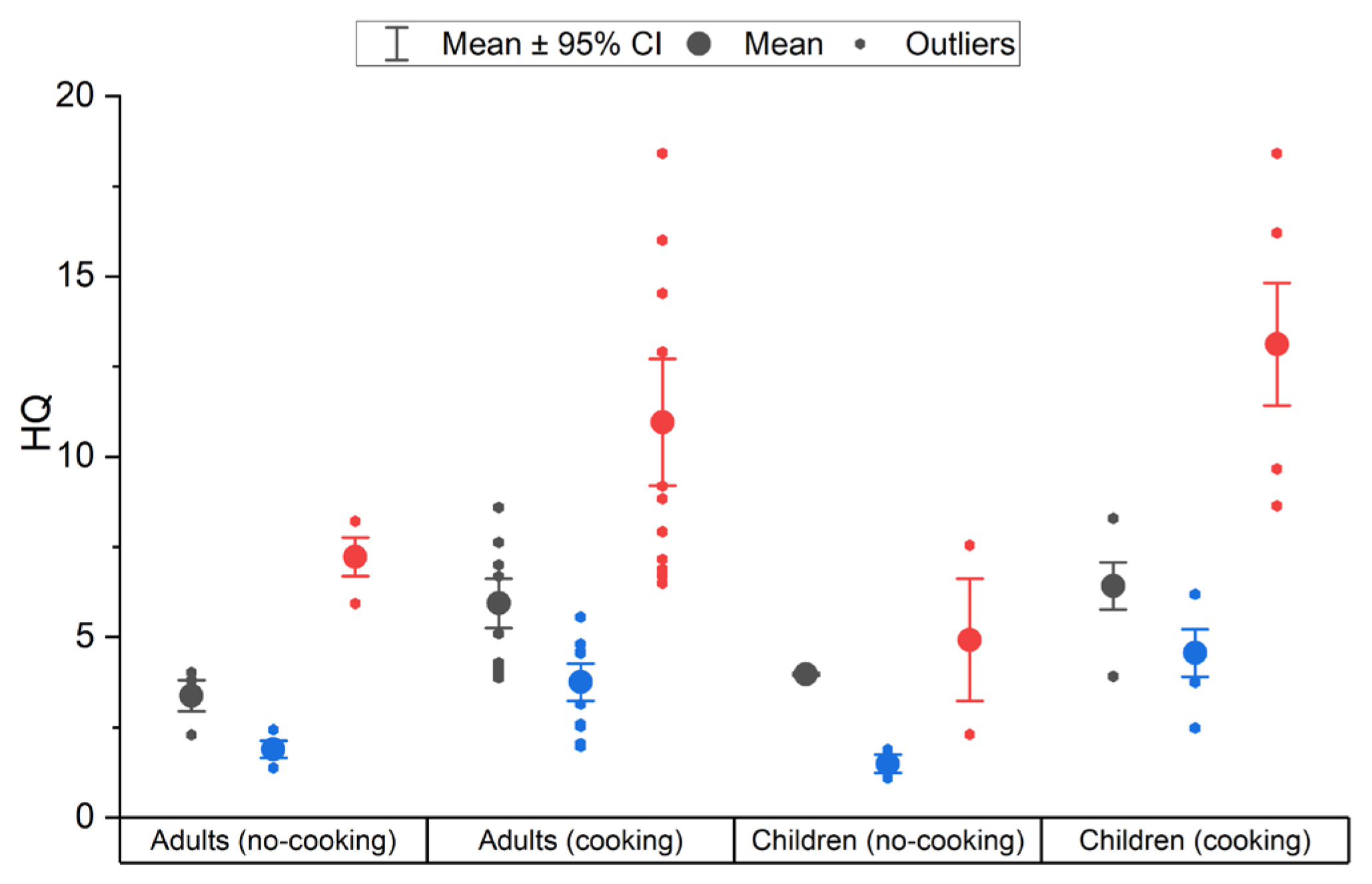
| Place | Measurement Location | Period | Average PM2.5 Conc. (µg/m3) | Reference |
|---|---|---|---|---|
| Akure, Ondo State | Kitchen (5 households) | 7 days | 9–27 (LPG, LPG/electricity, LPG/kerosene) | Kumar et al. [11] |
| Benin, Edo State | Kitchen (62 households) | 30–60 min (8:00–18:00) | 14–358 (electricity or LPG) 14–650 (kerosene or firewood) | Aigbokhaode and Isara [12] |
| Sango, Ogun State | Kitchen (38 households) | 49–158 min (5.45–10.00 or 17:30–20.30) | 64–102 (before cooking) 97–187 (during cooking with kerosene) | Giwa et al. [13] |
| Yenagoa, Bayelsa State | Kitchen (30 households) | 4 days (6:00–9:00 and 17:00–20:00) | 51 (kerosene) 37 (firewood) | Adianimovie and Ebinimi [14] |
| Three communities near Ibadan, Oyo State | Kitchen (59 households) | 1 h (before and during cooking) | 831–3437 (IQR during cooking with firewood, pre-intervention) 50–277 (IQR during cooking with firewood, post-intervention) | Oluwole et al. [15] |
| Olabisi Onabanjo University | Test kitchen | ~140 min (laboratory experiments) | 1129–1335 (during flying) 130–232 (after flying) | Giwa et al. [16] |
| Abuja, FCT | Living room (one residential building) | August–September 2022 (during daytime for two weeks) | 83 | Abulude et al. [17] |
| Akure, Ondo State | Two living/one kitchen/two others (a bungalow apartment) | January–February 2022 (one month) | 461, 695 (living rooms) 483 (kitchen) 350, 391 (other rooms) | Abulude et al. [18] |
| Akure, Ondo State | Living room (one household) | January/April/November/December | 42 (January)/25 (April)/36 (November)/55 (December) | Abulude et al. [19] |
| Benin, Edo State | Living room/basement (45 households) | April 2019–March 2020 (once per month) | 33–60 (wet season) 51–93 (dry season) | Eghomwanre et al. [20] |
| Akure, Ondo State | Kitchen and living rooms (6 households) | May 2020–September 2022 (depends on sites) | 12–75 (kitchen, wet season) 24–159 (kitchen, dry season) 7–20 (living room, wet season) 35–68 (living room, dry season) | This work |
| Site Name | A | B | C | I | J | K |
|---|---|---|---|---|---|---|
| Location | Akure S | Akure S | Akure N | Akure N | Akure N | Akure N |
| Latitude (°N) | 7.211 | 7.225 | 7.268 | 7.268 | 7.267 | 7.263 |
| Longitude (°E) | 5.175 | 5.172 | 5.252 | 5.254 | 5.254 | 5.258 |
| Observation period in kitchen | June 2020 –July 2022 | June 2020 –April 2022 | June 2020 –September 2022 | February 2021 –September 2022 | March 2022 –June 2022 | May 2021 –September 2022 |
| Observation period in living room | May 2020 –December 2021 | May 2020 –June 2022 | May 2020 –May 2021 | May 2021 –March 2022 | May 2021 –August 2022 | May 2021 –September 2022 |
| Type of kitchen where PM2.5 was monitored | Indoor kitchen | Indoor kitchen | Indoor kitchen | Indoor kitchen | Open outdoor kitchen | Indoor kitchen |
| Number of residents | 4 | 5 | 5 | 6 | 6 | 6 |
| Number of smokers | 0 | 0 | 0 | 0 | 1 | 0 |
| Fraction cooking fuel used in wet/dry season | ||||||
| -electricity (%) | 30/30 | 20/20 | - | 10/10 | - | 40/40 |
| -gases (%) | 50/50 | 70/70 | 55/60 | 80/80 | - | 50/50 |
| -kerosene (%) | 20/20 | 10/10 | 15/20 | -/10 | - | 10/10 |
| -charcoal (%) | - | - | 30/20 | - | - | - |
| -firewood (%) | - | - | - | 10/0 | 100/100 | - |
Disclaimer/Publisher’s Note: The statements, opinions and data contained in all publications are solely those of the individual author(s) and contributor(s) and not of MDPI and/or the editor(s). MDPI and/or the editor(s) disclaim responsibility for any injury to people or property resulting from any ideas, methods, instructions or products referred to in the content. |
© 2025 by the authors. Licensee MDPI, Basel, Switzerland. This article is an open access article distributed under the terms and conditions of the Creative Commons Attribution (CC BY) license (https://creativecommons.org/licenses/by/4.0/).
Share and Cite
Saetae, S.; Abulude, F.O.; Arasaki, K.; Ndamitso, M.M.; Akinnusotu, A.; Oluwagbayide, S.D.; Matsumi, Y.; Kawamoto, K.; Nakayama, T. Seasonal and Diurnal Variations of Indoor PM2.5 in Six Households in Akure, Nigeria. Atmosphere 2025, 16, 603. https://doi.org/10.3390/atmos16050603
Saetae S, Abulude FO, Arasaki K, Ndamitso MM, Akinnusotu A, Oluwagbayide SD, Matsumi Y, Kawamoto K, Nakayama T. Seasonal and Diurnal Variations of Indoor PM2.5 in Six Households in Akure, Nigeria. Atmosphere. 2025; 16(5):603. https://doi.org/10.3390/atmos16050603
Chicago/Turabian StyleSaetae, Sawanya, Francis Olawale Abulude, Kazushi Arasaki, Mohammed Mohammed Ndamitso, Akinyinka Akinnusotu, Samuel Dare Oluwagbayide, Yutaka Matsumi, Kazuaki Kawamoto, and Tomoki Nakayama. 2025. "Seasonal and Diurnal Variations of Indoor PM2.5 in Six Households in Akure, Nigeria" Atmosphere 16, no. 5: 603. https://doi.org/10.3390/atmos16050603
APA StyleSaetae, S., Abulude, F. O., Arasaki, K., Ndamitso, M. M., Akinnusotu, A., Oluwagbayide, S. D., Matsumi, Y., Kawamoto, K., & Nakayama, T. (2025). Seasonal and Diurnal Variations of Indoor PM2.5 in Six Households in Akure, Nigeria. Atmosphere, 16(5), 603. https://doi.org/10.3390/atmos16050603







